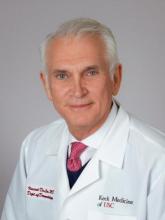Body lice presents an important public health concern due to the potential spread of infectious diseases. Dr. Vincent DeLeo talks with Dr. Dirk Elston about how to identify and manage human body lice infestations.
* * *
We also bring you the latest in dermatology news and research:
1. Skin manifestations are emerging in the coronavirus pandemic
2. NCCN panel: Defer nonurgent skin cancer care during pandemic
3. iPLEDGE allows at-home pregnancy tests during pandemic
* * *
Key takeaways from this episode:
- Human body lice are similar in appearance to head lice but can be differentiated based on the location of the infestation: “Body lice tend to lay their eggs in seams of clothing and on the fibers of hair in clothing rather than on the hairs on the head,” Dr. Elston notes.
- Body lice are transmitted through prolonged person-to-person contact associated with mass crowding, refugees, poverty, and homelessness.
- Patients with body lice typically present with generalized pruritus, maculated ceruleae, and hemosiderin deposits in the skin where the lice have fed, as well as lice and nits in the clothing.
- Body lice can be treated entirely with treatment of the clothing. “Pharmacologic intervention in the case of body lice is more for disease that the body louse may have spread,” Dr. Elston explains.
- Clinical signs and symptoms of body lice infestation include sepsis or more serious infection, typhus, eschar associated with other rickettsial-type diseases, endocarditis, cat scratch fever, acral splinter hemorrhages, and Osler-type nodes. “Most of these patients won’t present to us in clinic but more likely to [the] emergency department,” says Dr. Elston.
- Unlike body lice, head lice can be treated by shaving the head or other topical treatments. Combing through the hair has shown low efficacy rates. “Head lice are widespread. They know no economic or social boundaries. ... Fortunately, they are not known to be significant vectors of disease, but they are certainly a nuisance and something that carries a significant social stigma,” advises Dr. Elston.
- Transmission of lice is highly preventable. “[The] simple separation of clothing is the greatest intervention that we can do to prevent spread among schoolchildren, and it’s really a very simple and common-sense thing to do,” Dr. Elston says.
- If a patient has very coarse curly hair, pubic lice are more likely to infest the scalp than head lice. Pubic lice also are common in body hair, particularly in males, and are not just restricted to the pubic region.
* * *
Hosts: Nick Andrews, Vincent A. DeLeo, MD (Keck School of Medicine of the University of Southern California, Los Angeles)
Guest: Dirk M. Elston, MD (Medical University of South Carolina, Charleston)
Disclosures: Dr. DeLeo is a consultant for Estée Lauder. Dr. Elston reports no conflicts of interest.
Show notes by: Alicia Sonners, Melissa Sears
* * *
You can find more of our podcasts at http://www.mdedge.com/podcasts
Email the show: podcasts@mdedge.com
Interact with us on Twitter: @MDedgeDerm

